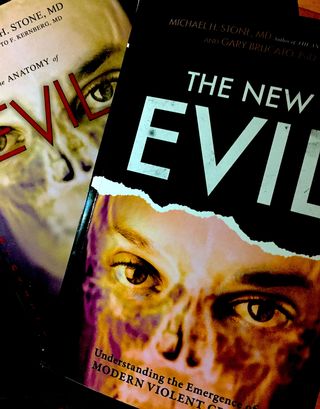Personality
All Things Truly Wicked
Forensic team deepens psychological analysis of the world’s worst offenders.
Posted March 18, 2019

Last week, Brenton Tarrant invaded two mosques in Christchurch, New Zealand, to slaughter people at prayer. He’d specifically targeted New Zealand, he said in an angry screed, to show that no place is safe. A sympathizer of white supremacy and admirer of other mass murderers, he hoped to inspire a chain-reaction of unrest and violence. Yes, he’s a disturbed man, full of violent rage. Many people around the world have also called him evil.
Tarrant is the type of person that forensic psychiatrist Michael Stone would have included in his comprehensive work about malignant acts, The Anatomy of Evil. Stone has now teamed up with clinical psychologist Gary Brucato to add more cases and deeper cultural analysis. Combining their extensive research and experience, they have produced The New Evil.
The book starts right out with a nightmare case: James Patterson Smith reported the accidental death of his seventeen-year-old girlfriend. But it was no accident. In fact, he’d kept her captive, inflicting more than 150 wounds to her body before she finally expired from the torment. She’d been starved to 44 pounds and been denied water for days. Smith had crushed her bones, gouged out her eyes, scalped her and mutilated her in many different ways. Ultimately, he’d bludgeoned and drowned her. During his trial, he claimed that the girl had inflicted these injuries on herself. His pattern of violence with other women went against him – not to mention how absurd it was to believe this girl could have carried out such extensive self-harm.
Smith's behavior certainly looks like evil, but Brucato discusses just how difficult it is to articulate the concept. Stone and Brucato have both spent decades evaluating child abusers, rapists, and killers, as well as researching the vilest acts that human beings can dream up. Some of their subjects are ill or impaired, some have serious personality disorders, and some are just predatory. Contrary to another author whose book I reviewed here, who believes that the notion of evil is relative, this team takes the position that regardless of religious persuasion or culture, some acts are universally so abhorrent and depraved that no one would challenge calling them evil.
Besides universality, say the authors, the other three fundamental elements that such acts share are malice aforethought, the infliction of wildly excessive degrees of suffering, and being incomprehensible to the average person. Many people who inflict such harm are capable of living ordinary lives. Thus, the descriptor attaches more to behavior than to people, unless an individual indulges in harmful atrocities with such frequency that he or she would earn it.
I once interviewed Dr. Stone, a professor of clinical psychiatry at Columbia University College of Physicians and Surgeons in Manhattan. He’d hosted a Discovery Channel series Most Evil, in which he interviewed extreme offenders. The series, like The Anatomy of Evil, was based on a measure of wickedness that he’d developed, the Gradation of Evil scale. Using it, he placed offenders on one of 22 different levels of a continuum. Based loosely on the concept of Dante’s Inferno, Stone’s evaluation device takes us deep into the heart of darkness.
“I used my responses to different murders and other violent crimes I read about as my yardstick,” he told me. “I tried to rank the various crimes and criminals according to how horrific and shocking they were, and according to the level of suffering that their acts imposed on the victims. After reading about one hundred biographies of criminals, I ended up with twenty-two categories. I anchored the scale to a ‘zero’ point, where there was no evil at all: that was for ‘justified homicide,’ category number one. Then came crimes of passion, the first level of evil, category number 2. At the opposite end, level number 22, was murder after prolonged torture of the most heinous type -- or even torture of that sort without murder.”
Stone recognizes that there is no “common route,” by which people become more likely to commit evil acts. Each subject has his or her own developmental trajectory, and the same constellation of factors that precipitate it in one person might not in another. “If we wanted to narrow our focus to single out the personality configuration that is connected with particular closeness to our concept of evil,” he writes, “it would be at the place where psychopathy, sadistic personality, and schizoid/autistic-spectrum disorders all come together.”
In this book, you’ll find examples for all 22 categories, along with an algorithm to assist with using the scale for future cases (such as Tarrant). Part II addresses the era of the “new evil,” which includes cultural changes over the past half-century that have influenced patterns of violence, including school shootings, gang violence, child abuse, and coercive paraphilias. You even get an alphabetized listing of offenders, and how they’d be rated.
Noted forensic psychiatric nurse, Ann Burgess, provides an Afterword. She offers an engaging backstory about the origins of Dr. Stone’s scale and addresses how the “coarsening of our culture” begs for such a sustained discussion about the atrocities we now see on almost a daily basis.
Don’t read this book before bed! You’re sure to get nightmares (especially from some of the pictures). Although the early chapters contain somewhat ordinary aggression, the book grows ever darker. Overall, it is a comprehensive review of raw, unrelenting acts of human violence. This impressive team of clinical experts, who have both seen wickedness up close, unflinchingly analyze acts of depraved aggression so we can better understand, predict and treat these individuals.
References
Stone, M. H., & Brucato, G. (2019). The new evil: Understanding the emergence of modern violent crime. Amherst, NY: Prometheus.




